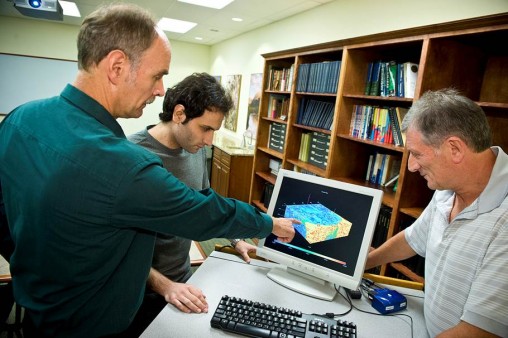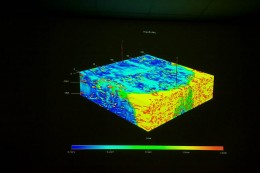
(Left to right) Earth and environmental sciences professor Robert Ritzi, student Reza Soltanian, research associate Naum Gershenzon
Schlumberger Limited, the world’s largest oilfield services company and a leader in environmental services, is drilling for good students at Wright State.
Schlumberger gave a $5 million geology software program to the College of Science and Mathematics’ Department of Earth & Environmental Sciences in 2011 and followed it up this year with another $5.8 million software gift.
They were the single largest gifts in the history of the department.
“This is standard software of the industry,” said Yi Li, dean of the College of Science and Mathematics. “Students with this kind of experience will look very strong on their resumes and be ready to dive into their work environment from the beginning.”
The first software gift transforms data into colorful, three-dimensional images of underground deposits, rock formations and reservoirs filled with oil and gas. The second gift helps users understand flow—the flow of oil and gas in reservoirs and the flow of groundwater in aquifers.
“The first part is primarily geared toward characterizing a reservoir by geophysical means—the extent of it, the thickness, exactly where it is, how it changes,” said David Dominic, Ph.D., professor of earth and environmental sciences and department chair. “The second part is geared toward modeling fluid flow through that reservoir. We’re grateful to Schlumberger for the donation.”
Wright State is using the software to train students both in oil and gas exploration and the cleanup of contaminated brownfield sites.
“We have students who intend to go to work in the energy industry and need to characterize and understand the flow of oil and gas,” said Robert Ritzi, Ph.D., professor of earth and environmental sciences. “And we have students who are going into environmental engineering and will work on cleaning up contaminated sites, so they need to understand how water and contaminants are moving underground.”
Schlumberger also supplied Wright State with a license that allows the software to run on the Ohio Supercomputer Center. The extreme computing power expands the scope of the software, resulting in increased resolution and greater detail.
“Working with high-quality software gives you the opportunity to really learn more about different processes,” said Reza Soltanian, who is working on his Ph.D. in the Earth & Environmental Sciences Department. “You can see everything in detail, and it’s fast.”
Soltanian is working with Naum Gershenzon, Ph.D., a research associate in Earth & Environmental Sciences. They are using the software to model complex flow patterns in order to enhance oil recovery. They are also using it to assess the viability of plans for the underground storage of industrially produced carbon dioxide in order to slow the accumulation of greenhouse gases and global warming.
Wright State has a well-established program and a strong reputation for applied geophysics, hydrogeology and environmental science. Ritzi said Wright State has long been unique among schools in the Midwest because petroleum companies have sought out its students.
“Our students are more marketable by being trained on the state-of-the-industry software,” Ritzi said. “It’s a good line item on the resume.”


 Wright State University Foundation awards Students First Fund grants
Wright State University Foundation awards Students First Fund grants  Cosmic collection
Cosmic collection  Wright State revives student-faculty collaborative writing journal
Wright State revives student-faculty collaborative writing journal  Fulfilling dreams
Fulfilling dreams  Wright State alumna Nicole Scherzinger wins top British theatre award as star of ‘Sunset Boulevard’
Wright State alumna Nicole Scherzinger wins top British theatre award as star of ‘Sunset Boulevard’ 